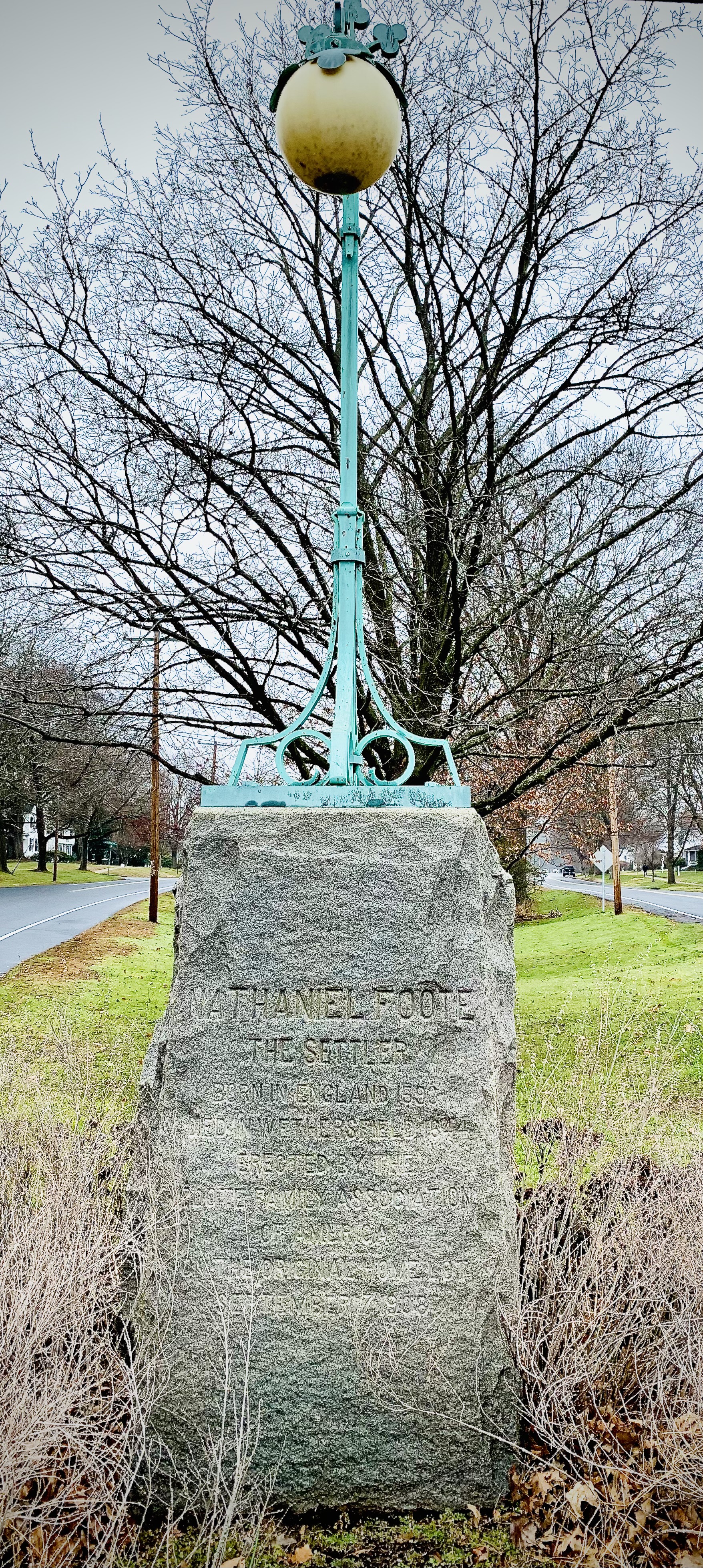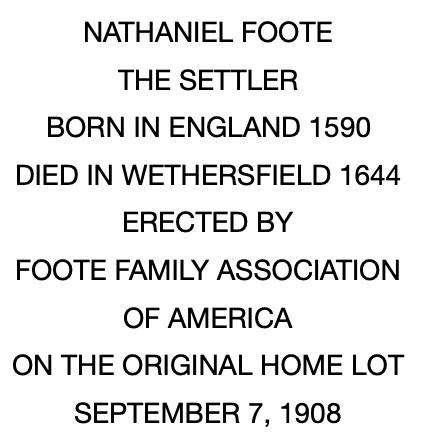“F Extra Documentation
“F Extra Documentation
Monument to Nathaniel Foote Wethersfield, Connecticut.
Located on the Wethersfield Green, at Coodinates (41.70400° N, 72.65510° W)
Celebrating Colchester’s Tricentennial, Part I
The Nathaniel Foote Stories
Local History by Kevin Tulimieri
COLCHESTER - Officially recognized by the General Assembly of the Colony of Connecticut on October 13, 1698, Colchester had close ties to the most exciting times in colonial history. Many of the people who had an influence shaping Colchester, also contributed greatly to the creation of Connecticut and America. To celebrate the Colchester Tricentennial, Local History will be presenting a series of articles highlighting some of the most important figures from 300 years of Colchester history.
From the beginning of English presence in Connecticut, the land which makes up Colchester was located in the territory of the Mohegan Indians. Since their first interaction, the Mohegans under the leadership of Uncas were close allies to the English. After an attack on the new settlement in Wethersfield in 1637, soldiers under Major John Mason were joined by Mohegan warriors for a raid on the Pequot village at Mystic. Uncas provided about 70 warriors and his knowledge of Pequot territory was a great benefit to the English forces. The strong Pequot tribe was disbanded and the bond between Uncas and the English was sealed. Years after the war; Uncas granted large tracts of land to Major Mason and many of his other English allies from the Pequot conflict.
Among the group of settlers living at Wethersfield during the attack in 1637 was Nathaniel Foote and his family. Nathaniel was part of the group of “Adventurers” who followed John Oldham to Wethersfield in 1634-35. Nathaniel was married to Elizabeth Deming in 1615 in England. Her brother, John Deming was also an early settler of Wethersfield with Oldham and Foote. The Foote’s first son, Nathaniel, was born in 1620, the same year the Pilgrims landed at Plymouth. In 1633, at about 40 years of age, and with a family of six children, Nathaniel, Sr., voyaged to Watertown, Massachusetts to create a new home. Leaving the crowded conditions around Boston, settlers followed Oldham to settle in the Connecticut wilderness. Nathaniel Foote and his two sons, Nathaniel and Robert, were with the earliest settlers, and Nathaniel, Sr. was the largest holder of “adventurers lands” in Wethersfield.
Two of the settlers killed in the 1637 attack on Wethersfield were Nathaniel Foote, Sr.’s neighbors Abraham and John Finch. While Nathaniel, Sr. was most likely too old to participate in the Pequot War, Nathaniel, Jr. was 17 years of age and may have been one of the 18 men Wethersfield sent on the campaign. Although not a military leader, Nathaniel, Sr. was involved in community affairs. Between 1641 and 1644, he served as a Deputy to the General Assembly, as well as a member of the colony Grand Jury. This high level in colonial government reached by Nathaniel, Sr. established a prominent position for the Foote family which would continue for generations. Nathaniel, Jr. inherited his father’s large estate in Wethersfield after his death in 1644. Nathaniel Sr.’s wife, Elizabeth, later remarried to Thomas Welles, who served as the Governor of the Connecticut Colony.
Nathaniel Foote, Jr. was married in Wethersfield in 1646, and on January 10, 1647, he had a son, Nathaniel, III. Unfortunately, Nathaniel, Jr., died in 1655 at the relatively young age of 34 years, leaving his wife with three young sons and a daughter. Nathaniel, III would follow in his father’s footsteps as a prominent landowner and a community leader. In 1659, a group of unhappy residents left Wethersfield to start a new town up the Connecticut River at Hatfield, now called Hadley. Nathaniel, III and two of his married sisters were among this group of restless settlers who pushed north, moving from the jurisdiction of Connecticut into Massachusetts.
In 1670, Nathaniel, III married Margaret Bliss of Hatfield. Life was difficult on the frontier and trouble was on the horizon for Nathaniel, III and his new wife. After years of dramatic increase in the English population in Massachusetts, the Wampanoag Indian Sachem Metacomet, known to the English as Kings Philip, urged the creation of an Indian federation to drive the English back into the ocean. With an attack on the village of Swansea, Massachusetts in 1675, King Philip’s War (began). Nathaniel Foote, III in Hatfield, and other towns of Hampshire County quickly became the center of the fighting. At the age of 28 years, Nathaniel, III joined the conflict and was commissioned as a Quarter Master of the Militia. King Philip’s War was a great strain on the young colonies, but by the end of 1676 the colonists defeated Metacomet and broke the Indian federation.
From Hatfield, Nathaniel, III moved his family to Springfield and then back to Connecticut at Stratford. Still restless, the Quarter Master moved his wife and three young children to Branford where he was accepted as a “planter.” After years of travel, Nathaniel, III returned to Wethersfield, by the time he had another daughter in 1679. Symbolic of the high status of Quarter Master Foote still carried in town, he was appointed Pound Keeper in 1683 and Constable in 1688. Skilled as a farmer and carpenter, in his later years Nathaniel, III studied law and is noted as an attorney in colonial court records. Adding to his family, Nathaniel, III and Margaret had a son in 1682, Nathaniel, IV. As a young man Nathaniel, IV would play an important role of establishing a community in Colchester.
During his time away from Connecticut, some important land grants opened Mohegan territory to the English. Beginning with Uncas’ grant to Major Mason in 1659, settlement along the ancient road between Hartford and New London was soon to follow. Another early grant in the Colchester area came about 1661, when Jeremiah Adams of Hartford was granted 340 acres “where he kept cattle last winter, going to Monhegin.” By Nathaniel, III’s return in the late 1670’s , Wethersfield had become an important center for trade with the Indians. It is reported that among the Indians who frequented the town was a “kinsman to Uncas, the Mohegan sachem.” Although no Indian is mentioned by name, there appears to have been some connection between the English at Wethersfield and the Mohegans. The Mohegan leader Uncas died about 1683 and was succeeded by his sons Owaneco and Attawanhoot, who was also known as Joshua Sachem.
By the early 1690’s, Quarter Master Foote is known to have been working to create a new settlement in Mohegan territory. He succeeded in contacting the Mohegans and purchasing a land grant from Owaneco. Unfortunately, the details of Nathaniel, II’s meeting with Owaneco have been lost. History reports that the grant was given to Quarter Master Foote by Owaneco, “for the consideration of love and affection.” The land was to be divided by Nathaniel, III “according to his (discretion or direction). The payment arrangement for this huge grant has also been lost, however, on report stated the land was purchased for one red coat, 25 silver buttons and a sizable amount of rum. The total cost to Quarter Master Foote is reported to have not exceeded $1.50 in value.
On October 13, 1698, the General Assembly accepted Foote’s grant and ordered: “This Court upon the petition of Divers of the inhabitants of the Countie of Hartford Grant Libertye for a plantation at or near the place called Jeremiah’s farme upon the road to newlondon… beginning at the North bound of twentie mile River AndSo to extend Southward to a River called deep River And to extend Eastward from the bounds of Haddam and Seven Miles.” With the acceptance of the colony leaders, Colchester was born. But settlement was difficult at first, confusion soon arose from unclear language of Quarter Master Foote’s grant and previous grants, including tje 1659 grant to Major Mason. Nathaniel, III appeared before the General Assembly in October, 1699 to reigister a complaint” “Michael Taintor, Saml Northan and Nath’l Foot appearing in this Assembly In the behalfe of the New plantation called Colchester and complaining that they are obstructed in the improvement and settlement of said plantation by reason of severall persons that claim considerable tracts of land within the grand of said Township, and partcularly serverall of the the inhabitants of Saybrook, This Court do therefore Order that all persons claiming any land there shall appear at the General Court in May next and make their claims appear, so that the Grantees may not be further obstructed…” The Court decided in favor of Quarter Master Foote and allowed the development of Colchester to continue.
The main thrust of settlement in Colchester began in 1701. Prominent families from Wethersfield, Windsor and Hartford joined together to create a new home in the wilderness. Quarter Master Foote came to town and started construction of a homestead about 1702. But ill health prevented him from finishing the structure. Nathaniel, III died in Wethersfield on January 12, 1703, from “a lingering consumption,” leaing his wife with nine children. His widow Margaret continued the transition to Colchester with her four sons and her youngest daughter. The oldest son was Nathaniel, IV who reached 21 years of age.
Finding himself as the head of the family, Nathaniel, IV finished the construction of Colchester’s historic Nathaniel Foote House. The original location of the house and the old town center was about a mile north of the present Town Green. Although moved from its original location, the Foote House still stands as a wonderful connection to one of the most important of Colchester’s town founders. With the completion of the other homesteads, fields were plowed and barns were raised. The next few years brought serious difficulties for the settlers at Colchester, but the town was now firmly established.
After generations of effort, the Foote family had lived through may formative events in New England history. With steady persistance, Quarter Master Nathaniel Foote, III and his descendants created a new home, a new town and a new country. Their efforts and the efforts of many other settlers built the Colchester we know today. Keep reading next week and Celebrate Colchester’s Tricentennial, Part 2.
Sources:
Foote Fmaily Genealogy by Nathaniel Goodwin, 1849
Taintor’s Records of Colchester, 1864
Historical Collections bny John Barber, 1838
Guide to the History and Historic Places in Connecticut by Mary Crofut, 1937
Records of the General Assembly of the Colony of Connecticut.
275th Anniversary of Colchester, McMinn, Jess and Tamburino, 1973


